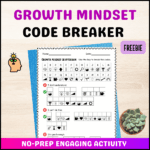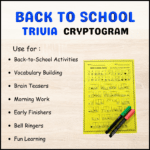Nurturing a Growth Mindset: A Guide for Parents and Teachers
Introduction
In today’s fast-paced and ever-changing world, fostering a growth mindset in children is more important than ever. A growth mindset, the belief that abilities and intelligence can be developed through dedication and hard work, can significantly impact a child’s academic and personal success. For parents and teachers, understanding and nurturing this mindset is crucial in helping children realize their full potential. This blog post explores the importance of a growth mindset, how it contrasts with a fixed mindset, and practical strategies to encourage this mindset in children.
The Best Growth Mindset Code Breaker Activity
Understanding Growth Mindset vs. Fixed Mindset
Growth Mindset: A growth mindset is the belief that abilities and intelligence can be developed over time. Children with a growth mindset understand that effort, persistence, and learning from mistakes are essential for growth. They are more likely to embrace challenges, persist in the face of setbacks, and see effort as the path to mastery.

Fixed Mindset: In contrast, a fixed mindset is the belief that abilities and intelligence are static and unchangeable. Children with a fixed mindset may avoid challenges, give up easily when faced with difficulties, and see effort as fruitless. They often fear failure and may feel threatened by the success of others.
The Importance of a Growth Mindset
Enhanced Learning and Achievement: Children with a growth mindset are more likely to embrace learning and view challenges as opportunities to grow. This positive attitude can lead to higher academic achievement and a deeper understanding of subjects.
Increased Resilience: A growth mindset fosters resilience by helping children see setbacks and failures as opportunities for growth. This perspective encourages them to persist through difficulties and develop the resilience to overcome obstacles.
Improved Confidence and Self-Esteem: Believing in their ability to improve through effort and practice boosts children’s confidence and self-esteem. They are more willing to take on new challenges and trust in their potential to succeed.
Better Problem-Solving Skills: A growth mindset encourages critical thinking and creativity, helping children approach problems with a solution-oriented attitude. They are more likely to explore multiple strategies and persist until they find a solution.
Positive Attitude Towards Lifelong Learning: Emphasizing that abilities can be developed through dedication and hard work instills a love for learning. Children with a growth mindset are more likely to become lifelong learners who continuously seek to improve themselves.
Practical Strategies for Parents and Teachers
Practical Strategies for Parents and Teachers
Model a Growth Mindset: Children often learn by observing the adults around them. Parents and teachers can model a growth mindset by demonstrating a positive attitude towards challenges, persisting through difficulties, and embracing mistakes as learning opportunities. Share your own experiences of overcoming obstacles and emphasize the importance of effort and persistence.
Use Growth Mindset Language: The language used by parents and teachers can significantly influence children’s mindset. Encourage children by praising their effort, strategies, and progress rather than their innate abilities. For example, instead of saying “You’re so smart,” say “I’m proud of how hard you worked on this project.”
Encourage a Love for Challenges: Create an environment where challenges are seen as opportunities for growth. Encourage children to take on tasks that stretch their abilities and provide support and guidance as they work through difficulties. Celebrate their efforts and progress, regardless of the outcome.
Teach the Value of Effort and Persistence: Help children understand that effort and persistence are key to achieving success. Share stories of people who achieved great things through hard work and determination. Encourage children to set goals and work steadily towards them, celebrating their efforts along the way.
Reframe Mistakes as Learning Opportunities: Teach children to view mistakes as valuable learning opportunities. When they make a mistake, discuss what can be learned from the experience and how they can apply that knowledge in the future. Encourage them to keep trying and to see failure as a natural part of the learning process.
Provide Constructive Feedback: Give feedback that focuses on the process rather than the person. Provide specific, actionable suggestions that help children improve their strategies and understand where they can make adjustments. Avoid labeling children as “smart” or “talented,” and instead emphasize their efforts and progress.
Encourage Curiosity and Exploration: Foster a love for learning by encouraging curiosity and exploration. Provide opportunities for children to explore new interests, ask questions, and seek out new experiences. Create a supportive environment where they feel safe to take risks and try new things.
Create a Supportive Learning Environment: Whether at home or in the classroom, create an environment that supports a growth mindset. Surround children with positive messages about effort, persistence, and the value of learning from mistakes.
- Use Growth Mindset resources: Using posters, cryptograms, and coloring pages that incorporate growth mindset reinforces the concept in a fun way.
Conclusion
Nurturing a growth mindset in children is a powerful way to help them achieve their full potential. By modeling a growth mindset, using positive language, encouraging challenges, and providing constructive feedback, parents and teachers can create an environment where children believe in their ability to grow and succeed. This mindset not only enhances academic performance but also builds resilience, confidence, and a lifelong love for learning. By working together, parents and teachers can empower children to embrace challenges, learn from their mistakes, and strive for continuous improvement, setting them on a path to lifelong success.









